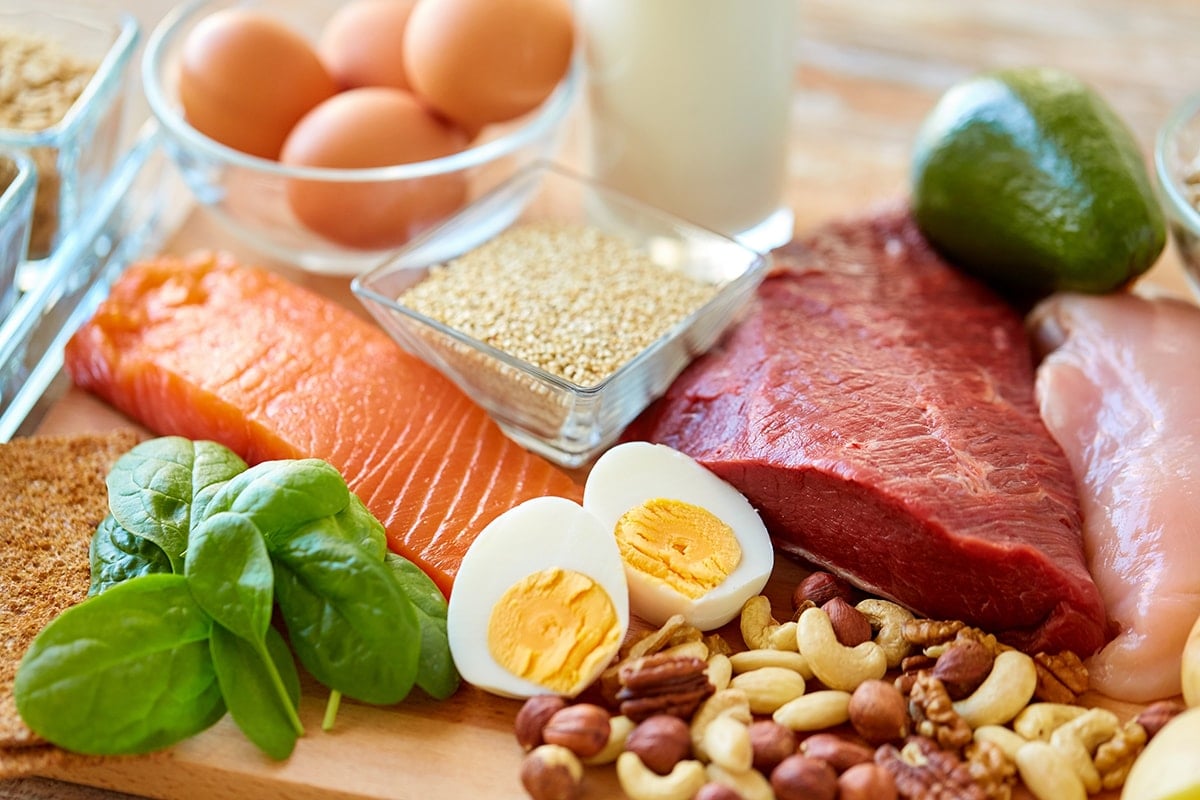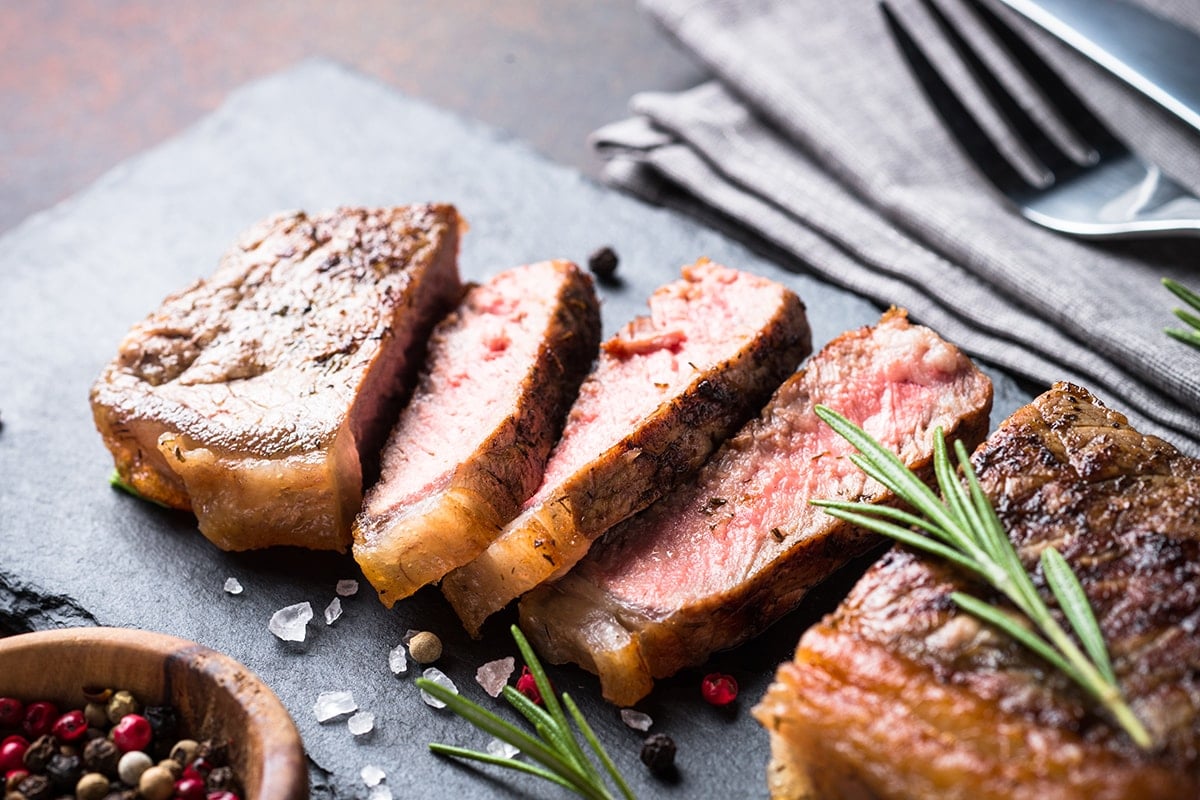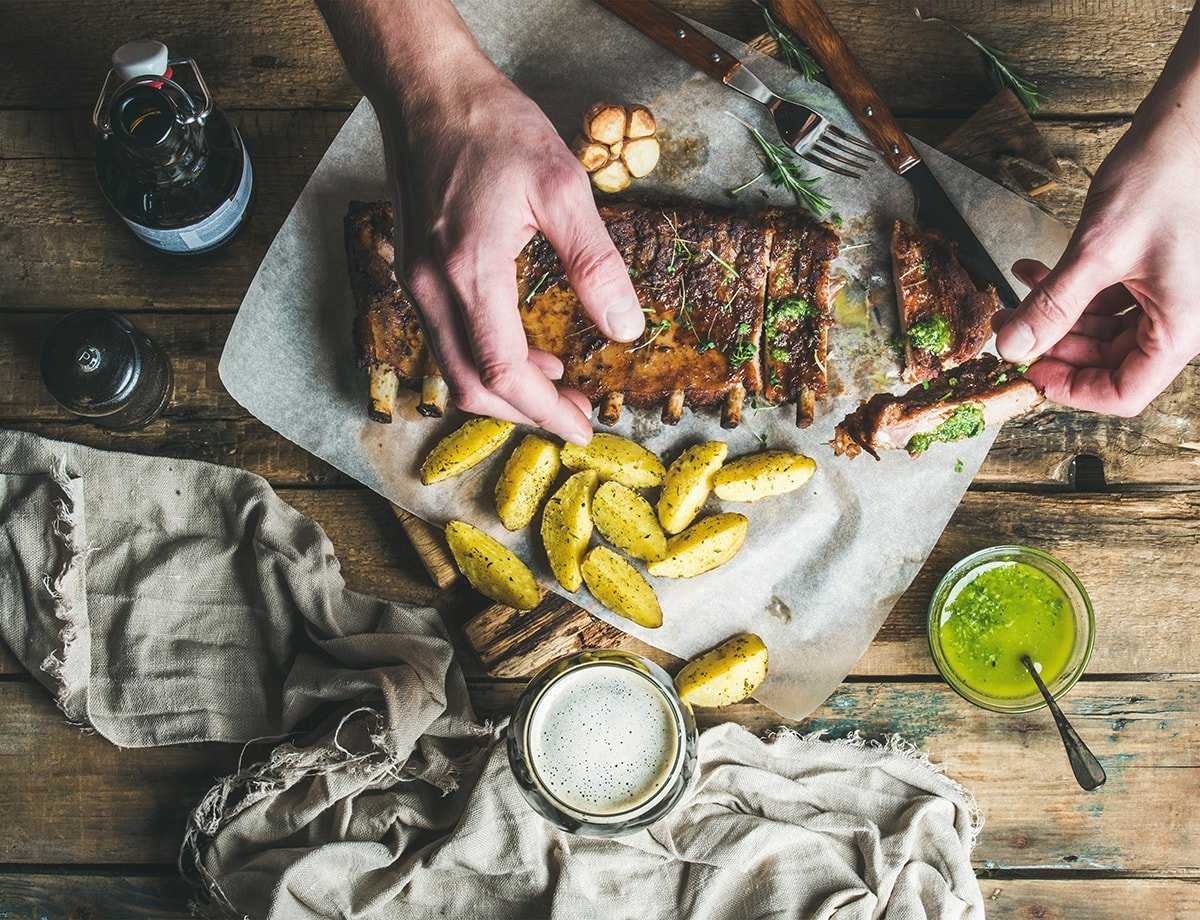
Have you ever wondered if protein is good for your skin? For the record… it is, especially if you plan on rebuilding healthy skin.
And one thing that I’ve found working with clients is that many people aren’t eating enough protein.
In fact, most people are quite surprised to discover just how low (suboptimal) their protein intake is!
This macronutrient is critical not just for building healthy new tissue, but for many other things in your body.
In this episode, I’m going to share with you why protein intake is so important and answer all of the questions you have about it!
Or, listen on your favorite app: iTunes (Apple Podcasts) | Spotify | Stitcher | TuneIn | Subscribe on Android
In this episode:
- Why protein is good (and necessary) to stop skin rashes
- Animal vs Plant protein – which is better?
- Why you can’t just use collagen
- How to figure out how much protein you eat now
- Recommended protein intake for chronic skin rashes
- Suggestions of healthy protein sources
Quotes:
You may have heard that you should cut back for the sake of your health (and that of the planet). But when your skin is compromised, it then becomes critical to get enough macronutrients like protein as well as micronutrients to refill the proverbial well.
Not getting enough protein is one of the biggest problems I see in my clinical practice when someone is hoping to rebuild healthy skin. They try their best based on all the information they find online, but the recommendations made for healthy people may not work for them. They are often surprised to discover that a higher protein intake improves symptoms overall as long as we ensure that it’s digested and absorbed.

Why Protein Is Good For Your Skin (And Solving Skin Rashes) (FULL TRANSCRIPT)
Welcome back to episode #65 of the Healthy Skin Show! In today’s episode, I’m going to talk about protein and why protein intake really matters.
It’s especially important when you’re working on rebuilding healthy skin! Whenever you’ve got to rebuild tissue, you have an increased need for protein.
This is especially true if you’re also struggling with…
- Autoimmunity
- Leaky gut syndrome
- IBS
- Chronic diarrhea or constipation
- Brain fog and memory recall
- Chronic fatigue
- Muscular weakness
- Poor sleep or even insomnia
- Food sensitivities
- Gut infections
You definitely can’t skimp on your protein intake!
Even though you might think that you can just get it from your muscles, that’s a bad idea. Catabolizing muscle tissue is not a good thing. So instead, we need to focus on bringing in enough to support new tissue building.
What I’ve found is that most of my clients aren’t eating enough protein. So let’s talk about the in’s and out’s of protein so you can make better choices for yourself.

What Does Protein Do In Your Body?
Protein that’s found in your diet and eaten is used to make new muscle tissue along with other tissue like new skin.
While that is really important, most people don’t know that protein is also used to make neurotransmitters, enzymes, hormones like thyroid hormone, and other chemicals. These are responsible for making sure that your body runs optimally on a daily basis.
Because I work with clients who are often addressing a number of different issues like gut infections, autoimmunity, chronic fatigue, thyroid issues, and brain function while reversing chronic skin rashes, protein intake is key.
The reality is that it’s pretty common to not consume appropriate levels of protein.
Often because you don’t know how much protein you need to eat.
And you may have heard that you should cut back for the sake of your health (and that of the planet). While these are certainly noble and reasonable concerns, someone on a healing journey does not have the same luxury as someone else who is healthy and well.
Being sick or unwell for long periods of time changes the game.
When your health is compromised, you have to remember that it then becomes critical to get enough macronutrients (protein, carbs, fat) as well as micronutrients (vitamins and minerals) to refill the proverbial well.
If you’re serious about getting better, it’s imperative to reduce or stop whatever is driving inflammation and focus on rebuilding healthy tissue. But to do that, you must have enough raw materials coming in to accomplish that goal.
I’ve worked with many eczema clients who were on all sorts of supplements for their skin before we started working together. But their protein intake turned out to be way too low! No amount of micronutrient supplements can fix all of the issues when the protein just simply isn’t available.
While I certainly applaud adding in more plants to your diet, it’s important to make sure that you’re eating enough protein.
The US is by no means a protein-starved nation. But don’t let that fool you into dropping your protein intake below what is appropriate for your particular circumstance.

Animal Protein vs Plant Protein — What’s Better?
If you’ve ever thought that all protein no matter the source is created equal, that’s sadly not true. It’s not critical for you to eat meat, per se.
But if you choose to avoid it for whatever the reason, you’ll need to be even more aware of your protein intake.
The reason is that a lot of plant-based protein (that’s also gluten-free) isn’t as protein-dense as animal products.
And some proteins like soy aren’t always advisable for everyone. Soy, as an example, is contraindicated for anyone with low thyroid function and Hashimoto’s Thyroiditis.
The question isn’t “which is better — animal protein or plant protein?”.
What you should ask instead is “how much protein your body will need to optimally function and rebuild healthy skin?”
Getting a balanced mix of plant and animal protein is ideal, but there are many more veg-friendly options out there now that can help someone who isn’t keen on eating meat or animal products.
Something to consider is that iron is generally better absorbed from animal protein versus plant protein. And even more so when Vitamin C from citrus fruit is included in the meal (lemon juice is an excellent choice).
Additionally, sulfur-rich amino acid proteins are more commonly found in animal products. Sulfur is an important micronutrient that is often used to help with chronic skin conditions like eczema, psoriasis, and seborrheic dermatitis as well as with your liver’s Phase 2 detoxification system.
That said, it’s possible to be sensitive to different forms of animal proteins (beef, eggs, dairy, fish). I’ve had clients diagnosed with an alpha-gal allergy making them allergic to all mammalian protein. While others have had pretty strong sensitivities to things like chicken, eggs, dairy, or even shellfish.
Whether you consume animals, fish, or plants, your decision should be one that’s focused less on dogma and more on what you need to heal. Find the best quality sources and focus on getting enough to allow your body to do this type of heavy lifting.

Why do you need to eat protein?
Unlike fat and carbs, there really aren’t any big protein storage centers in your body. That means you’ve got limited protein reserves to draw from when you don’t eat enough.
There are consequences to low protein intake.
When intake is too low, your body will steal the protein it needs from other areas that aren’t as critical to keep you alive.
Your skin is not as critical as your heart, brain, or kidneys. Skin is lower on the totem pole of organs.
To be clear, I’m by no means implying that your skin condition or any chronic illness is simply a lack of protein. But it is an important piece of the puzzle.
There are generally 16 root causes of chronic skin rash conditions. Typically people have 3 to 5 of these root causes. Low protein intake can definitely play a role.
You can also read more about the complexity of solving eczema HERE.

What Is Protein Made Of
When you eat protein, it doesn’t just get randomly plugged in anywhere in your body in the form that you ate it.
So let’s take a moment to talk about protein digestion.
Protein digestion begins in the stomach where the environment is meant to be really acidic. Enzymes help speed up the process of protein digestion as the food moves into your small intestine.
If you have low stomach acid or have taken acid-blocking medication for longer than a few months, digesting protein will be difficult. It’s surprisingly common to have low stomach acid!
{DOWNLOAD MY AT-HOME LOW STOMACH ACID TEST}
One sign of low stomach acid is if you stop eating meat, shift your diet more plant-based, and then see an improvement in your skin.
Plus those undigested proteins can be a trigger for gut issues like SIBO, leaky gut, and other GI problems. Here’s how SIBO is connected to skin issues like Rosacea!
Each protein is broken down into its smallest building blocks. These fragments are called Amino Acids.
Heading back to high school Biology 101 wasn’t what you had in mind today, but hang in here with me for a moment!
So imagine a big blob of Legos all stuck together. As a whole, this blob Legos is like a protein (say from a burger or beans) that you’ve eaten.
Each individual lego is a different amino acid.
Once the amino acids are pulled apart from each other, they can be absorbed in your gut. (If they aren’t broken down fully or absorbed, gut flora will ferment protein. That process is known as putrification which is highly inflammatory!)
Assuming you absorbed the amino acids, your body then uses them based on need and urgency.
In total, there are 20 different amino acids. Different combinations create all of the different proteins found on Earth.
Where things get tricky is that each amino acid is not all equal. Just like there are essential fatty acids (aka. Omega 3s), there are also essential amino acids.
Your body cannot produce or alter other amino acids in order to make essential amino acids. They must be consumed regularly or else you can become deficient.
A deficiency of any amino acid is a big deal.
When there is a lack of certain amino acid(s), your body can’t simply replace what’s missing with some other random amino acid. Each is different and has unique properties that make the end product — skin, muscle, hormones, etc. — work correctly.
Swapping even a single amino acid for another can cause serious problems in a healthy person. The effect can be even worse for you if you’ve got skin rashes.

Can’t I Just Supplement With Collagen?
Collagen protein has become increasingly popular due to a variety of claims (some accurate and some totally not) peddled by health experts.
That said, collagen is not a complete protein source! Nor should it be used as your sole protein supplement if you do not consume enough protein.
Doing so can contribute to amino acid deficiencies since collagen is predominately made up of two amino acids — Glycine and Proline.
Collagen can be incredibly helpful as an additional supplement for leaky gut syndrome, chronic skin rash issues, and joint problems. I often use it as part of my protocols with clients since it is a skin superfood!
And in case you’re wondering where collagen comes from — it’s derived from different types of animal and seafood sources. There are no vegan or vegetarian sources of collagen on the market despite the way some products are marketed.

How Much Protein Do You Need To Eat?
How much protein you need to eat daily depends on who you ask. It also depends on how healthy, active, and old you are.
Those who are very active (like a bodybuilder or a distance runner) will likely need more protein than someone who is sedentary. The RDA for a normal sedentary person is typically 0.8g/kg of your body weight.
If you’d like to convert your weight in pounds to kilograms, CLICK HERE to use this online calculator.
That said, if you’re trying to increase muscle mass (maybe you’ve been sedentary for a long time), research suggests that about 1g/pound of your ideal body weight is likely more effective!
BUT what all of these articles don’t address is how much protein to eat when you’ve got skin rashes (and possibly other issues under the surface).
Rebuilding healthy skin means you’re asking your body to do a lot of heavy lifting. That heavy lifting requires more raw materials (like those amino acids we talked about) to be available in order to get the job done right.
That said, if you’ve got kidney issues, talk to your doctor before increasing protein intake. Too much protein can overtax compromised kidney function and would be contraindicated.

How Much Protein Do You Need For Your Skin?
In my clinical practice, I recommend a higher protein intake range of 70g to 120g of protein daily. Where someone falls depends on their health status and a number of other factors.
Shoot for at least 70g to 80g each day is an excellent start if you’re not eating enough protein.
Keep in mind that higher protein intake is even more critical when it comes to healing wounds.
Sometimes protein intake amounts can be 2 to 2.5 times the number of kilograms of body weight.
If you have wounds due to your eczema, you may need a significantly higher amount of protein to help reseal the skin.

Tips to consume enough protein every day
Not getting enough protein is one of the biggest problems I see in my clinical practice when someone is hoping to rebuild healthy skin. They try their best based on all the information they find online, but the recommendations made for healthy people may not work for them.
They are often surprised to discover that a higher protein intake improves symptoms overall as long as we ensure that it’s digested and absorbed. (No putrification, right?)
But the biggest challenge to increasing protein intake is knowing practically how much protein you need to eat.
Frankly, no one knows what a gram looks like making it a bit challenging to figure out how to get enough in.
Step 1 is to figure out how much protein you eat on average now before making changes.
Use a nutrition tracker like https://www.myfitnesspal.com/ for 3 days to track everything you eat. Do not censor yourself here or alter your meals in any way.
You’ll get a baseline of the grams of protein you currently eat now. This will tell you how much extra you’ll need to consume and where you have gaps in your day to fill. For example, if you don’t eat any protein at lunch, then that would be a prime spot to add more in.
Then figure out how many protein grams you need daily by multiplying your weight (in kilograms) by 1.25 or even 1.5 depending on how sick you are (and how long you’ve been ill).
The more healing that’s required, the more protein that will likely be needed.

Best Food Sources Of Protein
If you eat a vegetarian or vegan diet, you will need to be especially aware of protein intake since many sources of plant-based protein aren’t nearly as protein-dense.
Most of my clients are shocked to discover that they have to eat more beans and nuts since I advise clients to avoid soy, tempeh, and seitan.
Additionally, many vegan sources of protein are not complete sources of protein. Thus the complete 20 amino acid spectrum isn’t present.
One trick to overcome this is with quinoa (which is a complete protein source). Also combining legumes and grains also gives you a complete protein source like the staple of rice and beans eaten throughout the world.
To make things easy, you could think about breaking up your protein intake throughout the day. Shoot for about 25g at each meal.
Use your nutrient tracker to help you learn how much protein is in what you eat. This helps make the numbers and information practical and applicable to real life.
In the future, you won’t need to count your protein grams because you’ll be able to approximate how much you eat.
A 1/4lb burger patty is about 23g to 25g of protein.
One chicken (or duck) egg equals 6 grams of protein while a full can of tuna has about 20 grams.
This is important and underscores why you can’t just eat one egg for lunch or a half can of tuna to truly get in enough protein.
As for legumes, here’s some quick numbers for you (obviously not a complete list):
- Chickpeas – 1 cup = 14.5g (source)
- Black beans – 1 cup = 15.2g (source)
- Pinto beans – 1 cup = 11.7g (source)
- Sprouted lentils – 1 cup = 6.9g (source)
- Amaranth (cooked) – 1 cup = 9.3g (source)
- Quinoa (cooked) – 1 cup = 8.1g (source)
- Split peas (cooked) – 1 cup = 16.3g (source)
As you can see, you’ve got to eat a lot of the more plant-based protein sources to equal what you’d get from an animal source.
One downside is the massive amount of starch that is also present in these foods. Excessive starches in your diet can be contraindicated for gut infections and hormone imbalances that can be a root cause for chronic skin rashes.
That said, it’s not impossible to see improvements on a vegetarian or vegan diet.
I’ve certainly had clients who are uncomfortable or against eating animal-derived products. We’ve just got to work a bit harder and smarter to keep them on the right track.
Protein powders can be a huge help since they can be made into protein shakes or added to yogurt, pudding, or oatmeal. FYI – vegan protein powders are often too low in protein based on their serving sizes and require a larger serving (to total closer to 25g).
If you have any issues digesting proteins (and you eat meat), this is one of my favorite protein powders because it’s totally broken down already into amino acids. It’s “pre-digested” and easy to absorb. It also tastes great too!
If you're more plant-based, this is another excellent vegan protein powder that's NOT gritty + blends very well.
One tablespoon of collagen powder adds about 6g of protein to your daily count. This is one of my favorite brands that offer collagen from cattle sources. You can also purchase a marine source collagen as well here.
If you've got any questions or thoughts about protein and protein intake, leave a comment below so we can continue the conversation!
Take a moment to rate and review the show on your podcast platform of choice and remember to share this episode with someone you know who trying to figure out how to fix their skin rashes naturally.
Thank you so much for tuning in and I will see you in the next episode!

Jennifer Fugo, MS, CNS
Jennifer Fugo, MS, CNS is an integrative Clinical Nutritionist and the founder of Skinterrupt. She works with women who are fed up with chronic gut and skin rash issues discover the root causes and create a plan to get them back to a fuller, richer life.





I have SIBO, increasing eczema, and many food and chemical sensitivities. I am underweight and cannot gain. I cannot find a functional doctor or coach to help me in this southwestern Indiana area. Can you tell me about working with you, or another practitioner you could recommend?
Could you please tell us why you don’t recommend your clients to eat tempeh, and seitan? How about natto?
Hi Eve, I generally recommend that clients go gluten-free due to its capacity to increase gut permeability. If you can find tempeh that is GF, then great. But it’s often not GF. Seitan is like a gluten-bomb… so it’s a hard pass. You could certainly try Natto as long as an allergy to soy isn’t present.
Another issue to consider is that these are fermented foods and for someone with histamine issues, these would not be great options until the underlying drivers of excess histamine and mast cell destabilization are addressed.
Just stumbled across this article researching my feeling that I do not get enough protein in my day.
I always LOVED putting collagen in my morning hot drink until I came to the conclusion that *all* protein powders gas me gas – and I’ve tried lots of the top notch healthy versions – no junk.
At this time – do you still recommend Quell protein? It is different enough from like Vital Proteins, Garden of Life or Great Lakes that maybe I could try it (knowing that a digesting protein seems to be an issue with me0?
Hi Joy, yes I do. Quell is my own line. Vital Protein + Great Lakes are collagen only. Garden of Life is a vegan blend that often has so many ingredients that you don’t know what you’re reacting to.
Are collagen powders high in oxalates? Does it affect people with oxalate intolerance?